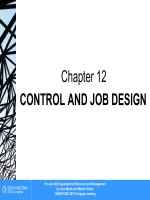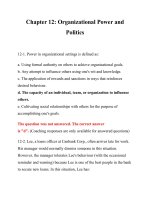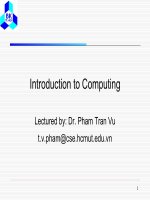Organizational behavior: Lecture 12 - Dr. Mukhtar Ahmed
Bạn đang xem bản rút gọn của tài liệu. Xem và tải ngay bản đầy đủ của tài liệu tại đây (362.05 KB, 46 trang )
Organizational
Behavior
(MGT-502)
Lecture-12
Summary
of
Lecture-11
Attribution
The Process through which
individuals attempt to
determine the causes of others
behavior
Fundamental Attribution Error
The tendency to attribute others’
actions to internal causes (e.g their
traits) while largely ignoring external
factors that also may have influenced
their behavior.
Frequently Used Shortcuts in
Judging Others
• Selective Perception
– People selectively interpret what they see on the basis of their
interest, background, experience, and attitudes.
• Halo Effect
– A general impression about an individual is based on a single positive
characteristic.
• Contrast Effects
– Evaluations of a person’s characteristics that are affected by
comparisons with other people recently encountered who rank
higher or lower on the same characteristics.
• Projection
– Attributing one’s own characteristics to other people
• Stereotyping
– Judging someone on the basis of the group to which he/she belongs.
Impression Management
Self-presentation
Is the process by which people attempt
to manage or control the perceptions
other form of them.
Today’s Topics
Perception &
Decision Making
The Link Between Perceptions
and Individual Decision Making
Problem: A discrepancy between
some current state of affairs and
some desired state.
Perceptions
Perceptions
of
ofthe
the
decision
decision
maker
maker
Decisions: The choices made
from among two or more
alternatives.
Outcomes
Rational Decision-Making
Model
A decision-making model
that describes how
individuals should behave
in order to maximize
some outcomes.
Assumptions of the Rational
Decision-Making Model
One:
Four:
Problem Clarity
Constant Preferences
Two:
Five:
Known Options
No Constraints
Three:
Six:
Clear Preferences
Maximum Payoff
Steps in the Rational
Decision-Making Model
1.Define the problem.
2.Identify the decision criteria.
3.Allocate weights to the criteria.
4.Develop the alternatives.
5.Evaluate the alternatives.
6.Select the best alternative.
Rational Model of Decision Making
TECH
Set Decision
Criteria
Problem
Identify and
Define Problem
Criteria
Weight
the Criteria
A1
A2
+
A1
A1
A2
A2
A3
Choice
A4
Make Optimal
Decision
An
Develop
Alternatives
An
An
Evaluate
Alternatives
Problem Solving
Vs
Decision Making
– Problem solving: finding the root
cause of a deviation (cause analysis)
– Decision making: choosing from
alternative courses of action (choice
analysis)
Problem solving
Decision making
Alternatives to
Rational Decision- Making
• Bounded Rationality
• Intuitive Decision-making
• Decision-Making by Objection
• The Garbage Can Model
Bounded Rationality
Scan the Environment
Design Possible Solutions
Choose from among available
alternatives (Satisfice)
Intuitive Decision-Making
Rely on Experience
(“Gut Feeling”)
Intuitive Model
Use Personal Assessment
(Compatibility Test)
Decision-Making by Objection
• Don’t make matters worse.
• Form rough description of acceptable
resolution.
• Propose a course of action.
• Secure objections - they set the
boundaries.
• Repeat process, creating several
courses of action.
The Garbage Can Model
• Problems and solutions change.
• Problems and solutions often present
themselves simultaneously.
• Pair problems and solutions.
The Garbage Can Model
Solutions
Problems
Problem A
+
m
Proble
A
Problem C
P r ob
Solution X
lem B
nX
o
i
t
Solu
Solutio
nZ
Solution Y
How are Decisions Actually
Made in Organizations
• Bounded Rationality
– individuals make decisions by constructing
simplified models that extract the essential
features from problems without capturing all
their complexity.
• Intuitive Decision Making
– An unconscious process created out of
distilled experience.
A Model of Bounded Rationality
Ascertain
the Need
for a Decision
Select
Criteria
Identify a
Limited Set
of Alternatives
Compare
Alternatives
Against Criteria
Simplify
the Problem
Expand
Search for
Alternatives
Select the
First “Good
Enough” Choice
A “Satisficing”
No
Alternative
Exists
Yes
Intuitive Decision Making
High uncertainty levels
Little precedent
Hard to predictable variables
Limited facts
Unclear sense of direction
Analytical data is of little use
Several plausible alternatives
Time constraints
Decision-Making Styles
Research on decision styles has identified four different
individual approaches to making decisions.
– Directive Style -- people using this style have a low
tolerance for ambiguity and seek rationality.
– Analytic Style -- people using this style have a much
greater tolerance for ambiguity than do directive decision
makers.
– Conceptual Style -- people tend to be very broad in their
outlook and consider many alternatives
– Behavioral Style -- people who tend to work well with
others.
Tolerance for Ambiguity
Decision-Style Model
High
Analytical
Conceptual
Directive
Behavioral
Low
Rational
Intuitive
Way of Thinking









